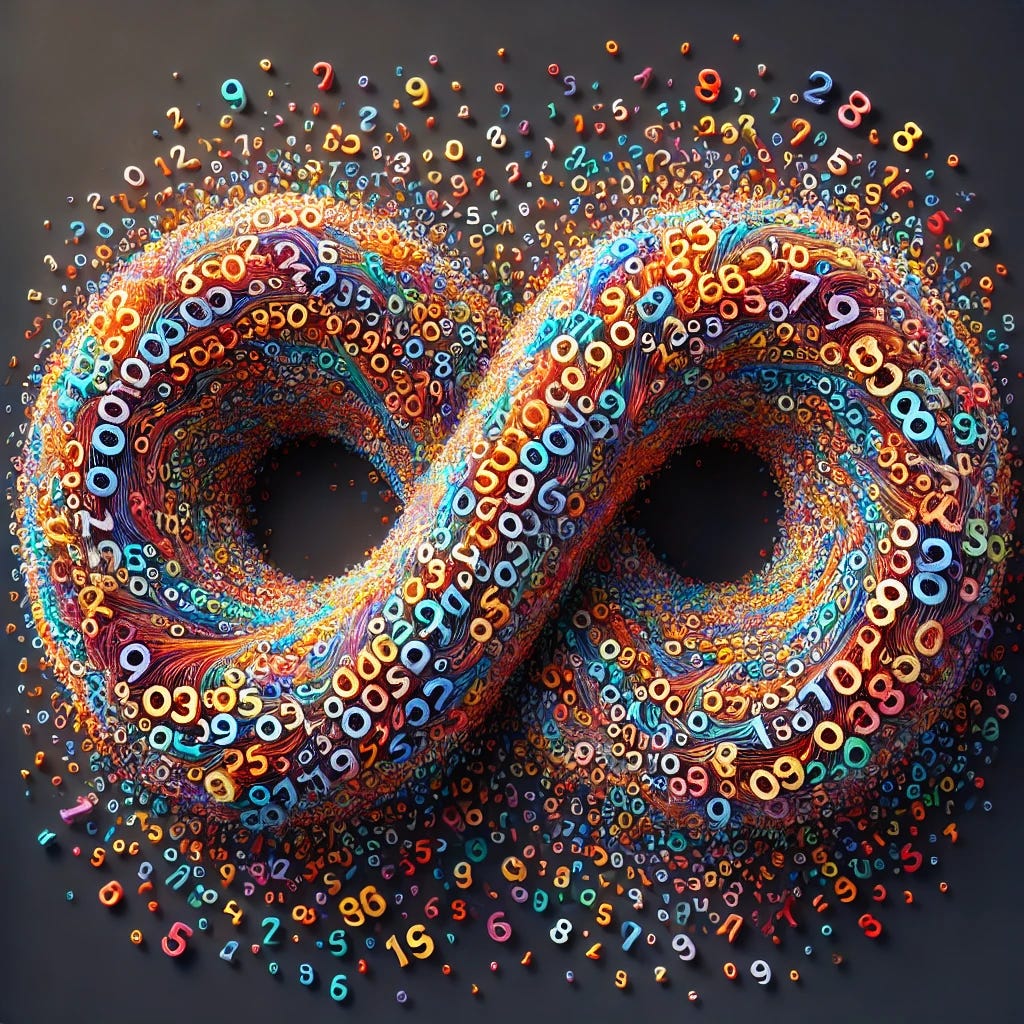There are different ways to think about the concept of infinity.
That might sound kind of odd: either there’s an infinite number of things, or there’s not. How is there any gray area here?
During the 19th century, a German mathematician named Georg Cantor came up with a novel idea. You could compare two sets of numbers by looking at each one side by side. If every number in a set had a corresponding number in the other set, that would indicate the same number of numbers.
Cantor considered all of the natural numbers like 1, 2, 3… and realized that you could clearly identify each number, and then sort of mentally lay these numbers out along a really long line. If you do the same exercise with, say, even numbers only—2, 4, 6—you might think this type of infinity would be smaller.
What Cantor showed is that you can line these numbers up, one by one, and so there was a sort of correspondence between the sets. This wasn’t only true for the even numbered set, but also for sets of numbers that seemed like they ought to be much bigger than the set of natural numbers, like including negative numbers or decimals into the mix.
It wasn’t true for irrational numbers, though. This type of infinity was different. The problem arose because of infinity itself: you can cram an infinite amount of irrational numbers onto a line in between two real numbers, and there’s no way to represent all of those numbers with a real number on the other line.
Cantor showed that there’s an infinity of irrational numbers for every single real number, so there’s no way the two types of infinity could be the same. He called the first type of set a countable infinity, and the second one uncountable.
This was earth-shattering for the world of mathematics, and the reverberations made their way into the field of physics, where things were already starting to turn completely upside down. The very nature of space and time were on the chopping block, and the way everything worked was being refined in some places, and completely reconsidered in others.
In other words, this was perfect timing for serious physicists to consider some crazy-sounding ideas about infinity. For one, the universe itself might be infinite.
The universe might be infinite seems like a pretty straightforward statement, but what kind of infinity are we talking about here?
On one hand, maybe there’s infinite matter and energy (they’re the same thing) and an infinite amount of space. We can tell that the universe is expanding, so space is continuing to stretch out while the matter gets further and further apart. While it’s impressive that we know that, it doesn’t tell us anything at all about whether or not that imaginary canvas (space) goes out to infinity, or whether there’s an infinite amount of matter in the cosmos.
Infinite space with finite matter is also pretty easy to imagine. The matter and energy is constantly stretching out in this scenario, but it will never reach the end, because there isn’t an end. If you check back in a kajillion-jillion years, you still won’t be anywhere near the end.
Similarly, finite space and finite matter is easy enough for us to conceive, since that’s how most terrestrial things seem to work.
By contrast, a universe with finite space and infinite matter seems to be logically contradictory. If you have infinite stuff, it should take up infinite space, and if you don’t have infinite space, you have a logical fallacy. However, you can technically solve this one by making the matter infinitely dense, and that’s one interpretation of black holes.
Let me paint a different scenario for you now, though: what about a universe that’s finite in terms of how much matter there is, but unbounded in terms of the direction you can travel in?
If you’ve read the above sentence carefully, you might be scratching (or maybe shaking) your head. How could something allow you to go in one direction forever? By ending up back in the same spot, of course.
This is how our planet works: if you start walking due east, and you assume you have the magical ability to continue walking across water and through various other substrates, you will end up right back where you started.
To an ant walking around a tree branch, the surface looks completely flat, but if that ant continues walking around, it will return to the same spot. Similarly, in a finite but unbounded universe, you could shoot an imaginary laser off in one direction, only to have that same laser hit you in the back of the head later on.
I’ve come to think of this sort of concept as the “Ms Pac Man Universe.” If you’ve ever played the game, you probably already know what I’m going to point out:
Ms Pac Man is not bound by the edge of the screen—she just goes right on to the other side as if nothing has happened, then keeps going.
In a finite but unbounded universe, something could theoretically move in one direction forever, unless it hit something else along the way.
It’s tantalizing to apply the concept Cantor introduced to physics. This idea that a type of infinity that could potentially live within something finite, like with natural numbers on a line with infinite irrational numbers between them, can be applied just as easily to the physical world we inhabit.







So Ms. Pac-Man can be infinite, but Mr. Pac-Man can't?
Not gonna lie - haven’t finished reading this but had to pause to comment on how I initially thought this essay’s image was an elaborate donut with the fanciest sprinkles ever!